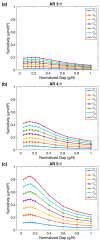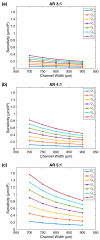Optimizing Sensitivity in a Fluid-Structure Interaction-Based Microfluidic Viscometer: A Multiphysics Simulation Study
- PMID: 38005651
- PMCID: PMC10675072
- DOI: 10.3390/s23229265
Optimizing Sensitivity in a Fluid-Structure Interaction-Based Microfluidic Viscometer: A Multiphysics Simulation Study
Abstract
Fluid-structure interactions (FSI) are used in a variety of sensors based on micro- and nanotechnology to detect and measure changes in pressure, flow, and viscosity of fluids. These sensors typically consist of a flexible structure that deforms in response to the fluid flow and generates an electrical, optical, or mechanical signal that can be measured. FSI-based sensors have recently been utilized in applications such as biomedical devices, environmental monitoring, and aerospace engineering, where the accurate measurement of fluid properties is critical to ensure performance and safety. In this work, multiphysics models are employed to identify and study parameters that affect the performance of an FSI-based microfluidic viscometer that measures the viscosity of Newtonian and non-Newtonian fluids using the deflection of flexible micropillars. Specifically, we studied the impact of geometric parameters such as pillar diameter and height, aspect ratio of the pillars, pillar spacing, and the distance between the pillars and the channel walls. Our study provides design guidelines to adjust the sensitivity of the viscometer toward specific applications. Overall, this highly sensitive microfluidic sensor can be integrated into complex systems and provide real-time monitoring of fluid viscosity.
Keywords: deflection; fluid-structure interaction; microfluidic viscometer; micropillar; multiphysics simulations.
Conflict of interest statement
The authors declare no conflict of interest.
Figures






Similar articles
-
A micropillar-based microfluidic viscometer for Newtonian and non-Newtonian fluids.Anal Chim Acta. 2020 Oct 23;1135:107-115. doi: 10.1016/j.aca.2020.07.039. Epub 2020 Jul 27. Anal Chim Acta. 2020. PMID: 33070846
-
A highly accurate and consistent microfluidic viscometer for continuous blood viscosity measurement.Artif Organs. 2010 Nov;34(11):944-9. doi: 10.1111/j.1525-1594.2010.01078.x. Epub 2010 Oct 14. Artif Organs. 2010. PMID: 20946281
-
Electrofluidic Circuit-Based Microfluidic Viscometer for Analysis of Newtonian and Non-Newtonian Liquids under Different Temperatures.Anal Chem. 2018 Feb 6;90(3):2317-2325. doi: 10.1021/acs.analchem.7b04779. Epub 2018 Jan 16. Anal Chem. 2018. PMID: 29293313
-
Soft hydraulics: from Newtonian to complex fluid flows through compliant conduits.J Phys Condens Matter. 2021 Nov 18;34(6). doi: 10.1088/1361-648X/ac327d. J Phys Condens Matter. 2021. PMID: 34678790 Review.
-
Flexible Electronics toward Wearable Sensing.Acc Chem Res. 2019 Mar 19;52(3):523-533. doi: 10.1021/acs.accounts.8b00500. Epub 2019 Feb 15. Acc Chem Res. 2019. PMID: 30767497 Review.
References
-
- Preetam S., Nahak B.K., Patra S., Toncu D.C., Park S., Syväjärvi M., Orive G., Tiwari A. Emergence of microfluidics for next generation biomedical devices. Biosens. Bioelectron. X. 2022;10:100106. doi: 10.1016/j.biosx.2022.100106. - DOI
LinkOut - more resources
Full Text Sources

